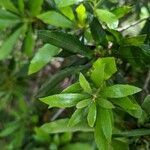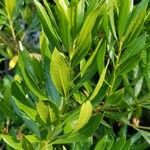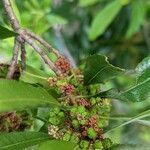Shrubs or small trees , evergreen, 2-10 m. Branchlets green when young, becoming red-brown, eventually black to gray with age, densely gland-dotted, glands colorless to black, pilose to villous, ultimately glabrous. Leaf blade fragrant when crushed, narrowly elliptic to elliptic-oblanceolate, 4-13 × 0.7-3.1 cm, sometimes membranous, more commonly leathery, base cuneate-attenuate, margins variable, from nearly entire (less common) to remotely and coarsely serrate entire length of blade, apex acute; surfaces abaxially pale green, adaxially dark green, shiny, both surfaces gland-dotted; glands colorless to black, considerably more dense abaxially, midrib pilose to glabrate adaxially. Inflorescences: staminate 0.6-1.7(-2.5) cm; bisexual 0.6-1.9(-3) cm; flowers bisexual, staminate, or pistillate within any 1 spike. Staminate flowers: bract of flower shorter than staminal column, margins opaque and densely ciliate; stamens (2-)6-12(-22). Pistillate and bisexual flowers: bracteoles usually persistent in fruit, 4-6, not accrescent or adnate to fruit wall, margins ciliate; stamens 1-5, in bisexual flowers hypogynous, free or often adnate to ovary, especially near styles; ovary ± villous, especially at apex. Fruits globose-ellipsoid, 4-6.5 mm; fruit wall glabrate to sparsely villous, obscured by enlarged, glabrous protuberances, with or without light to very heavy coat of white wax.
More
A shrub or small tree. It grows up to 8 m high. The trunk can be 30 cm across. It is evergreen. The leaves are alternate and simple. They are narrow and 5-10 cm long. They are bright green on the upper surface and have glands underneath. There are coarse teeth along the edge near the base. The leaves have a smell when bruised. The male and female flowers are in separate clusters on the same plant. The fruit are round. They are 4-6 mm across. The fruit is dark purple.




